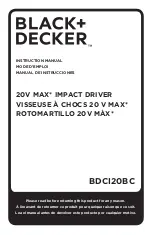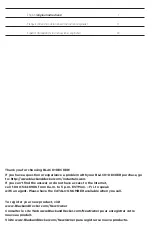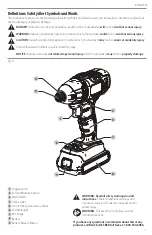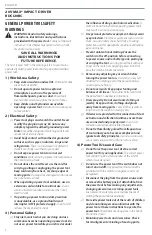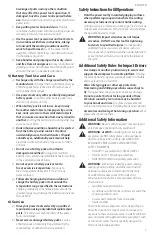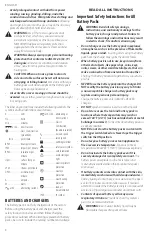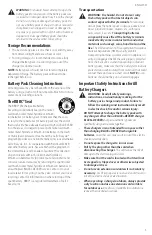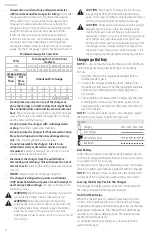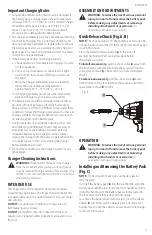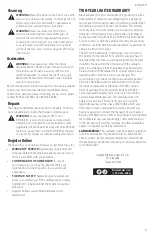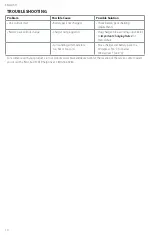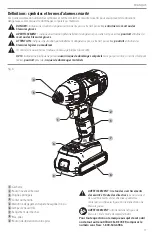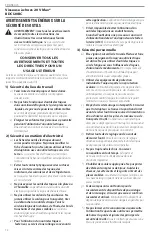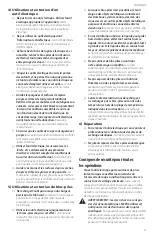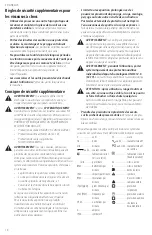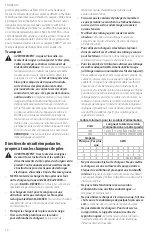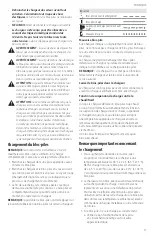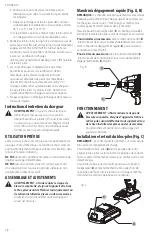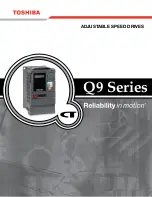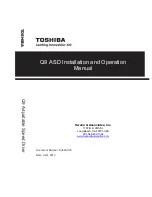
3
English
Safety Instructions for All Operations
•
Hold the power tool by insulated gripping surfaces,
when performing an operation where the cutting
accessory or fastener may contact hidden wiring.
Cutting accessory or fasteners contacting a "live" wire may
make exposed metal parts of the tool "live" and could give
the operator an electric shock.
WARNING: Impact wrenches are not torque
wrenches. DO NOT use this tool for tightening
fasteners to specified torques.
An independent,
calibrated torque measurement device such as a
torque wrench should be used when under tightened
or over tightened fasteners can lead to the failure of
the joint.
Additional Safety Rules for Impact Drivers
•
Use clamps or another practical way to secure and
support the workpiece to a stable platform.
Holding
the work by hand or against your body leaves it unstable
and may lead to loss of control.
•
Wear safety goggles or other eye protection.
Hammering and drilling operations cause chips to
fly.
Flying particles can cause permanent eye damage.
•
Do not operate this tool for long periods of time.
Vibration caused by tool action may be harmful
to your hands and arms.
Use gloves to provide extra
cushion and limit exposure by taking frequent rest periods.
•
Accessories and tools get hot during operation.
Wear
gloves when touching them.
breakage of parts and any other condition
that may affect the power tool’s operation. If
damaged, have the power tool repaired before
use.
Many accidents are caused by poorly maintained
power tools.
f )
Keep cutting tools sharp and clean.
Properly
maintained cutting tools with sharp cutting edges are
less likely to bind and are easier to control.
g )
Use the power tool, accessories and tool bits etc.
in accordance with these instructions, taking
into account the working conditions and the
work to be performed.
Use of the power tool for
operations different from those intended could result
in a hazardous situation.
h )
Keep handles and grasping surfaces dry, clean
and free from oil and grease.
Slippery handles and
grasping surfaces do not allow for safe handling and
control of the tool in unexpected situations.
5) Battery Tool Use and Care
a )
Recharge only with the charger specified by the
manufacturer.
A charger that is suitable for one type
of battery pack may create a risk of fire when used
with another battery pack.
b )
Use power tools only with specifically designated
battery packs.
Use of any other battery packs may
create a risk of injury and fire.
c )
When battery pack is not in use, keep it away
from other metal objects, like paper clips, coins,
keys, nails, screws or other small metal objects,
that can make a connection from one terminal to
another.
Shorting the battery terminals together may
cause burns or a fire.
d )
Under abusive conditions, liquid may be ejected
from the battery; avoid contact. If contact
accidentally occurs, flush with water. If liquid
contacts eyes, additionally seek medical help.
Liquid ejected from the battery may cause irritation
or burns.
e )
Do not use a battery pack or tool that is
damaged or modified.
Damaged or modified
batteries may exhibit unpredictable behavior resulting
in fire, explosion or risk of injury.
f )
Do not expose a battery pack or tool to
fire or excessive temperature.
Exposure to
fire or temperature above 265 °F (130 °C) may
cause explosion.
g )
Follow all charging instructions and do not
charge the battery pack or tool outside the
temperature range specified in the instructions.
Charging improperly or at temperatures outside the
specified range may damage the battery and increase
the risk of fire.
6) Service
a )
Have your power tool serviced by a qualified
repair person using only identical replacement
parts.
This will ensure that the safety of the power
tool is maintained.
b )
Never service damaged battery packs.
Service
of battery packs should only be performed by the
manufacturer or authorized service providers.
Additional Safety Information
WARNING:
Never modify the power tool or any part
of it. Damage or personal injury could result.
WARNING: ALWAYS
use safety glasses. Everyday
eyeglasses are NOT safety glasses. Also use face or
dust mask if operation is dusty. ALL USERS AND
BYSTANDERS MUST ALWAYS WEAR CERTIFIED
SAFETY EQUIPMENT:
• ANSI Z87.1 eye protection (CAN/CSA Z94.3),
• ANSI S12.6 (S3.19) hearing protection,
• NIOSH/OSHA/MSHA respiratory protection.
WARNING:
Some dust created by power sanding,
sawing, grinding, drilling, and other construction
activities contains chemicals known to the State
of California to cause cancer, birth defects or
other reproductive harm. Some examples of these
chemicals are:
• lead from lead-based paints,
• crystalline silica from bricks and cement and other
masonry products, and
• arsenic and chromium from chemically-
treated lumber.
Your risk from these exposures varies, depending on
how often you do this type of work. To reduce your
exposure to these chemicals: work in a well ventilated
area, and work with approved safety equipment, such
as those dust masks that are specially designed to
filter out microscopic particles.

